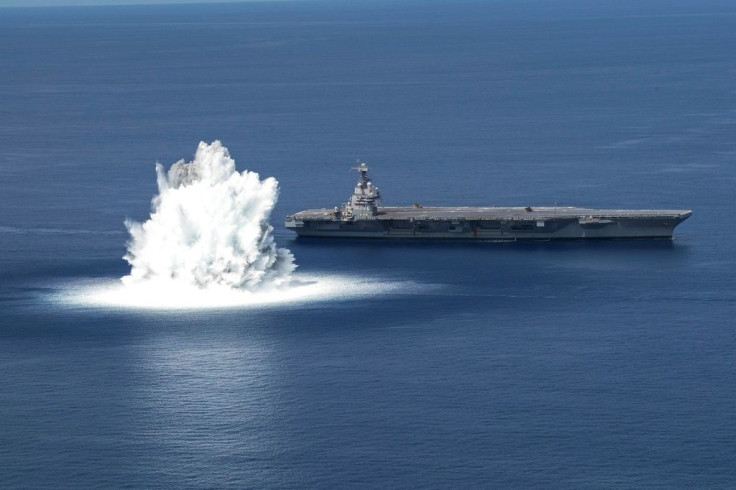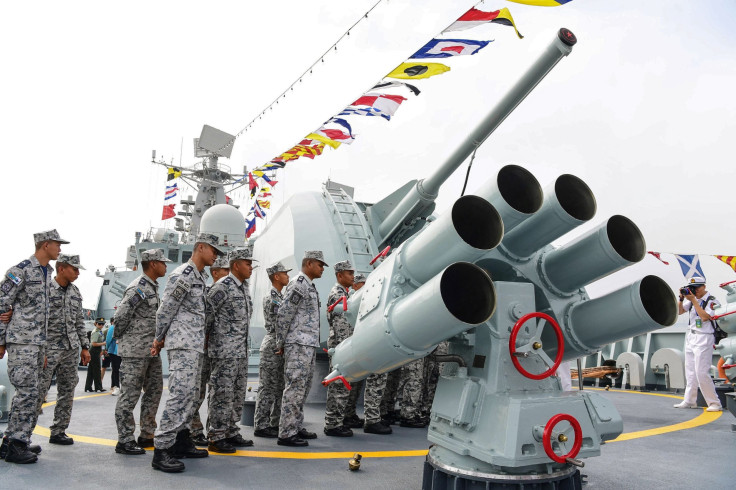Chinese Researchers Simulate Bombing, Destroying 'Unsinkable' US Fleet Using 24 Hypersonic Missiles

KEY POINTS
- Military planners concluded the USS Gerald R. Ford carrier fleet could be destroyed using 24 hypersonic missiles
- During the simulation, China's military used a three-wave attack against the U.S. fleet
- Chinese researchers said lure tactics and patrol missions would help increase the effectiveness of China's missiles
A team of Chinese military planners has simulated bombing and destroying an aircraft carrier group that was deemed the U.S. Navy's most superior using hypersonic weapons.
The researchers' war game simulations showed that Chinese forces used 24 hypersonic anti-ship missiles to destroy the USS Gerald R. Ford carrier fleet, which comprise the aircraft carrier, a cruiser, and four guided missile destroyers, South China Morning Post (SCMP) reported.
Following 20 simulated battles, which were run on a mainstream war game software platform used by China's military, the military planners determined that the U.S. carrier fleet "previously regarded as unsinkable by conventional weapons" could be "destroyed with certainty" by a relatively small number of hypersonic strikes, the report said.
In the simulation, the U.S. vessels are attacked after they continue to approach a China-claimed island in the highly-disputed South China Sea despite repeated warnings.
The Chinese military showed "unusual prowess in their sophisticated launch strategy," which used a three-wave attack to deceive and overwhelm the defense systems of the U.S. carrier group, the researchers said in their paper detailing the war game.
China's People's Liberation Army (PLA) used in the simulation its sea-based surveillance network to detect the U.S. carrier group before launching eight less-reliable hypersonic missiles simultaneously from southern and central sites in the country, according to the military planners.
These were followed by eight of the more accurate Chinese hypersonic missiles launched from northern and western China, with four focused on the CVN-78 Gerald R. Ford aircraft carrier while the others targeted the four DDG-103 Arleigh Burke-class Flight IIA guided missile destroyers, the researchers said.
Two of the less accurate missiles were launched at the CG56 Ticonderoga-class cruiser the San Jacinto, according to the paper.
The PLA then launched its third and final missile attack, known as a "mop-up" operation, using six less accurate hypersonic missiles launched from southern sites in China.
Cao Hongsong of the North University of China led the team of researchers who conducted the war game simulations, and their results were published in the Chinese-language Journal of Test and Measurement Technology in May.
It is the first time the results of simulated hypersonic strikes against a U.S. carrier group have been published.
The Chinese researchers suggested that using lure tactics would increase the effectiveness of Chinese hypersonic missiles while reducing the number of defense missiles available to the U.S. fleet.
They added that using patrol missions to identify targets ahead of attacks would allow the Chinese military to conserve ammunition.
A Beijing-based aerospace defense industry engineer, who wished to remain anonymous due to the sensitivity of the issue, reacted to the results of the war game simulations.
"The accuracy of the data used in war game simulations is critical to their usefulness in evaluating potential scenarios," the unnamed engineer told SCMP.
"If the data about Chinese hypersonic missiles used in this war game simulation is far from reality, it could affect the quality of the simulation and lead to inaccurate conclusions," they added.
China has already made public its ambition to deter and even sink U.S. naval vessels.
In 2018, Rear Admiral Luo Yuan, the deputy head of the Chinese Academy of Military Sciences, revealed in a military forum that China's anti-ship ballistic and cruise missiles can hit U.S. aircraft carriers despite being defended by other vessels.
Luo said the loss of one aircraft carrier could cost the U.S. the lives of 5,000 servicemembers.
"We'll see how frightened America is," he said, News.com.au reported.

© Copyright IBTimes 2025. All rights reserved.






















